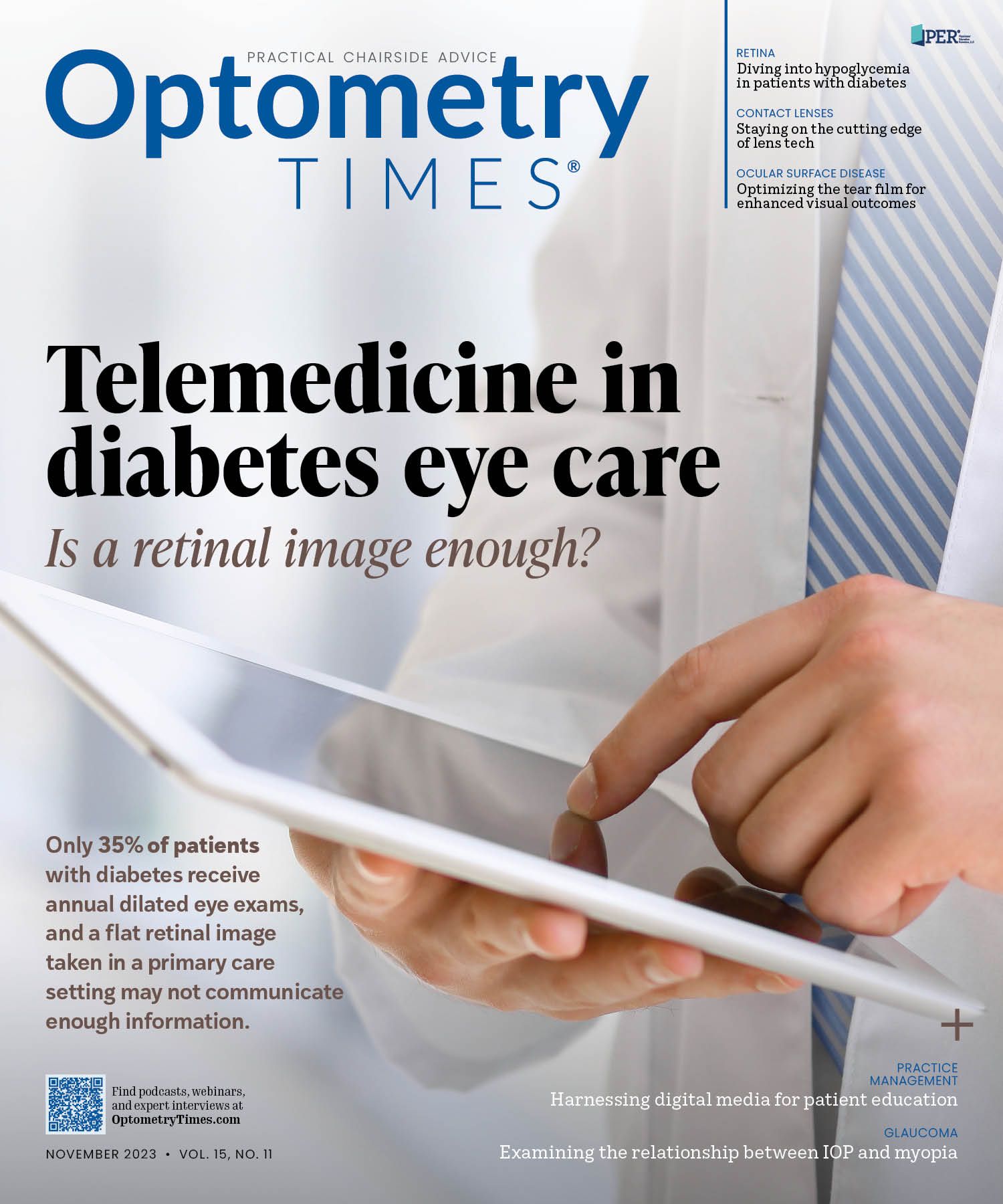Keep your contact lens practice on the cutting edge
Fitting the right lens requires a detective's mindset.
Image credit: Adobe Stock/Tyler Olson

Recently, I saw a 47-year-old woman who was referred to our practice by an existing patient. She had worn the same brand of reusable contact lenses for several years but had gradually cut down on her wear time—to the point that she was now only wearing contact lenses for special occasions and outdoor exercise. Discomfort was a major part of the problem, but this patient also told me she didn’t feel comfortable driving at night while wearing her lenses because of glare, and that she was really tired of taking reading glasses on and off. She was ready to give up on contact lenses altogether—until a coworker of the same age started raving about the Acuvue Oasys Max 1-Day Multifocal (Johnson & Johnson Vision) lenses I had prescribed for her.
This case illustrates so many things about how to run a successful contact lens practice. First, I don’t ever want my patients to hear about new technology from someone else. I make it a priority that my staff and I stay abreast of the latest innovations so that we can offer better products before patients start complaining—and certainly before they are ready to drop out of lens wear.
With mature patients, you also can’t address just one need in isolation. I like to think of this age group as being more rewarding because they are the most likely of any age group to refer others. They are highly motivated: 94% of current contact lens wearers older than 40 years expect to continue wearing contact lenses in the future.1 But they do have some very real challenges that all need to be addressed, including dryness, presbyopia, and difficulty with light scatter and glare.
We know that the tear film necessary to support healthy, comfortable contact lens wear becomes less stable with age.2 In fact, many patients in the 40- or 50-plus age range have underlying dry eye or meibomian gland dysfunction that requires treatment. No matter how wonderful a contact lens you prescribe, it likely won’t satisfy the patient if you don’t also treat underlying dryness and tear film issues. In my office, that might mean a prescription for daily pharmacological treatment or an in-office procedure such as intense pulsed laser, LipiFlow vectored thermal pulsation, or another form of meibomian gland heat and expression. After that, patients with dry eye certainly need to be fit in one of the newest materials available. Every contact lens manufacturer is constantly working to develop lenses that maintain hydration better than their earlier-generation lenses. Personally, I prefer lenses with wetting agents that are incorporated throughout the entire matrix of the lens, rather than lens coatings.
Secondly, we know that by the late 40s, loss of accommodation begins to make soft spherical lens wear untenable—at least without constantly reaching for readers, as this patient reported disliking.
In fitting patients with presbyopia, refraction is the most important factor. I like to perform a fresh spherical subjective refraction in ambient light. I avoid overminusing by performing a binocular balance and red/green balance after the subjective refraction. We need to look for the best functional add power—that is, the lowest add that allows the patient to see most of what they want in their environment for their daily activities. For most people, that isn’t J1. It is also important to determine sensory dominance, or which eye is most sensitive to plus power defocus. Although this is often the same as sighting dominance, it can be different from the sighting eye in up to 40% of cases.3 With a multifocal fit, if better near vision is needed I only add plus power to the sensory nondominant eye to increase patient acceptance and maximize distance binocular summation. The importance of binocular summation is the major reason I prefer a good multifocal contact lens over monovision, which can have a detrimental effect on summation as disparity is increased. Following these steps and using the manufacturer’s fit guide will help stack the deck in favor of success with the first or second pair of lenses, saving the clinician and patient time and avoiding frustration.
The third barrier to success in contact lenses for this patient was glare at night. We know that light scatter increases with age, resulting in starbursts and halos that can be particularly bothersome at night.4 Although it is trendy to talk about blue light as a problem associated with handheld devices, the reality is that high-energy blue and violet wavelength light is all around us. Blue light from car headlights, streetlights, and other LED lighting in our environment contributes to scatter and visual quality deterioration. It is surprising to me that not all contact lenses block UV light, let alone violet and blue. I won’t fit a contact lens that doesn’t block UV light unless there is a strong reason for doing so.
The solution for this patient
I fit this patient in Acuvue Oasys Max 1-Day Multifocal, a new daily disposable silicone hydrogel contact lens that addresses all 3 of her challenges. The manufacturing process relies on a new curing process to optimize distribution of the wetting agent throughout the lens and at the surface. And the OptiBlue light filter is unique among contact lenses available in the US, blocking up to 60% of blue-violet light to reduce scatter and improve visual clarity. For reference, this is an even greater level of high-energy light filtration than is available in most blue-blocking spectacle lenses.
For her refraction (–2.75 –0.50 ×175 OD and –2.00 sphere OS) and add requirement of +1.25 D, the fit guide recommended a starting pair of –3.00 LOW for the sensory dominant right eye and a –2.00 LOW for the nondominant left eye. After the initial fit, the patient was mostly satisfied but wanted a little better near vision, so we made 1 adjustment, a –1.75 LOW lens for the left eye, which made the patient very happy. She reports being able to wear the lenses longer and feeling more confident driving at night.
Not the only ones struggling
Although we often think about patients with presbyopia as being our most challenging, it’s important to offer the latest contact lens technology to patients of all ages. I have noticed that even my patients in their 20s are struggling more with dryness than they used to, most likely due to their increased digital device usage. These young people are just starting out in their careers and typically have long workdays, after which they still want to go out and enjoy their personal time in the evening without removing their lenses. And they are using their devices socially, as well. Overall screen time has increased by up to 35% since 2019.5 When looking at a computer or phone screen, people blink up to 60% less, destabilizing the tear film and leading to dryness and tired eyes.6,7 Those habits aren’t going away, so we really need to seek out lenses that protect against blue-violet light and dryness for our patients of all ages.

A commitment to new technology is the way I have grown my practice over the past 40 years, while also providing the best possible patient service. My patients know that they are always going to get the “latest and greatest” when they come to our offices, and I believe that is what keeps them coming back, year after year.
References:
IPSOS global incidence tracker, retail outlet consumption data and national census population data in US. 2018.
Mostafa YMSE, Saif MYS, Saeed MA, and ElSaadany SAM. The effect of age and gender on tear film breakup time. Egyptian Journal of Medical Research. 2021;2(2):137-148. doi:10.21608/EJMR.2021.174931
Lopes-Ferreira D, Neves H, Queiros A, Faria-Ribeiro M, Peixoto-de-Matos SC, González-Méijome JM. Ocular dominance and visual function testing. Biomed Res Int. 2013:238943. doi:10.1155/2013/238943
Van Den Berg TJP, Van Rijn LJR, Michael R, et al. Straylight effects with aging and lens extraction. Am J Ophthalmol. 2007;144(3):358-363. doi:10.1016/j.ajo.2007.05.037
COVID-19: Screen time spikes to over 13 hours per day, according to Eyesafe Nielsen estimates. Eyesafe. March 28, 2020. Accessed June 2023. https://eyesafe.com/covid-19-screen-time-spike-to-over-13-hours-per-day
Tsubota K, Nakamori K. Dry eyes and video display terminals. N Engl J Med. 1993;328(8):584. doi:10.1056/NEJM199302253280817
Patel S, Henderson R, Bradley L, Galloway B, Hunter L. Effect of visual display unit use on blink rate and tear stability. Optom Vis Sci. 1991;68(11):888-892. doi:10.1097/00006324-199111000-00010
